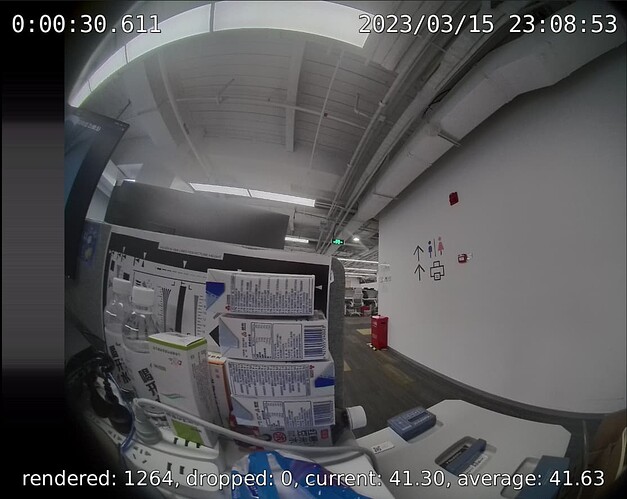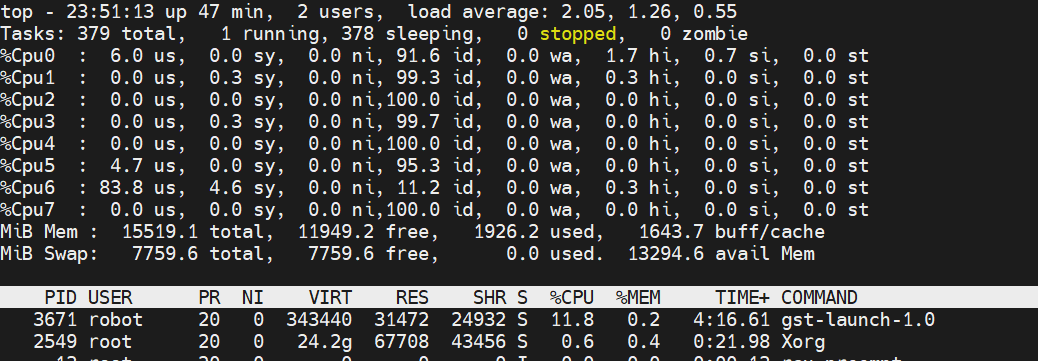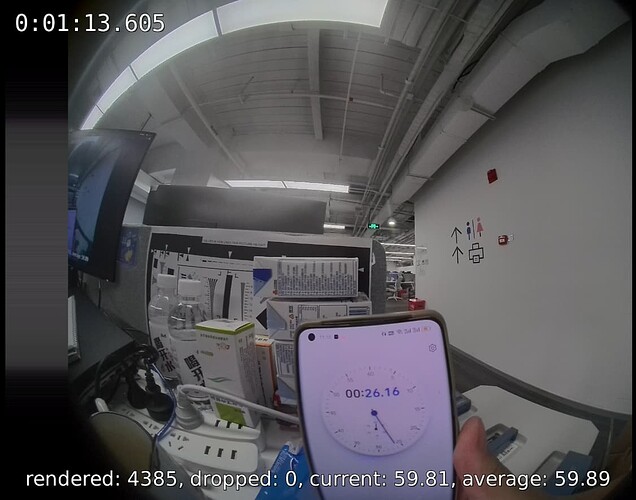Hi all:
Why is the frame rate of v4l2 60fps, but gstreamer shows 41fps?
Device:
Orin NX
Soft Version:
jp5.1.2
Command:
gst-launch-1.0 -ev v4l2src device=/dev/video3 ! timeoverlay ! clockoverlay halignment=right valignment=top time-format=“%Y/%m/%d %H:%M:%S” ! video/x-raw, width=1920, height=1536 ! videoconvert ! fpsdisplaysink sync=false 2>&1
root@tegra:/home/robot# more /etc/nv_tegra_release
# R35 (release), REVISION: 4.1, GCID: 33958178, BOARD: t186ref, EABI: aarch64, DATE: Tue Aug 1 19:57:35 UTC 2023
root@tegra:/home/robot# v4l2-ctl --list-formats-ext --device /dev/video3
ioctl: VIDIOC_ENUM_FMT
Type: Video Capture
[0]: 'YUYV' (YUYV 4:2:2)
Size: Discrete 1920x1080
Interval: Discrete 0.033s (30.000 fps)
Size: Discrete 1920x1536
Interval: Discrete 0.017s (60.000 fps)
Size: Discrete 1920x1280
Interval: Discrete 0.033s (30.000 fps)
Size: Discrete 1920x1380
Interval: Discrete 0.033s (30.000 fps)
Size: Discrete 1920x1440
Interval: Discrete 0.033s (30.000 fps)
Size: Discrete 1600x1300
Interval: Discrete 0.033s (30.000 fps)
[1]: 'YUYV' (YUYV 4:2:2)
Size: Discrete 1920x1080
Interval: Discrete 0.033s (30.000 fps)
Size: Discrete 1920x1536
Interval: Discrete 0.017s (60.000 fps)
Size: Discrete 1920x1280
Interval: Discrete 0.033s (30.000 fps)
Size: Discrete 1920x1380
Interval: Discrete 0.033s (30.000 fps)
Size: Discrete 1920x1440
Interval: Discrete 0.033s (30.000 fps)
Size: Discrete 1600x1300
Interval: Discrete 0.033s (30.000 fps)
root@tegra:/home/robot# v4l2-ctl -d /dev/video3 --get-fmt-video
Format Video Capture:
Width/Height : 1920/1536
Pixel Format : 'YUYV' (YUYV 4:2:2)
Field : None
Bytes per Line : 3840
Size Image : 5898240
Colorspace : sRGB
Transfer Function : Default (maps to sRGB)
YCbCr/HSV Encoding: Default (maps to ITU-R 601)
Quantization : Default (maps to Limited Range)
Flags :
root@tegra:/home/robot# v4l2-ctl -d /dev/video3 --set-ctrl sensor_mode=1 --set-fmt-video=width=1920,height=1536 --stream-mmap
<<<<<<<<<<<<<<<<<<<<<<<<<<<<<<<<<<<<<<<<<<<<<<<<<<<<<<<<<<<<< 59.86 fps
<<<<<<<<<<<<<<<<<<<<<<<<<<<<<<<<<<<<<<<<<<<<<<<<<<<<<<<^C
root@tegra:/home/robot# gst-launch-1.0 -ev v4l2src device=/dev/video3 ! timeoverlay ! clockoverlay halignment=right valignment=top time-format="%Y/%m/%d %H:%M:%S" ! video/x-raw, width=1920, height=1536 ! videoconvert ! fpsdisplaysink sync=false 2>&1
DTS:
dts.txt (447.2 KB)
The CPU usage is not high either, so why do the displayed frame rates differ when the commands are different?
60fps:
gst-launch-1.0 -ev v4l2src device=/dev/video3 ! timeoverlay ! rawvideoparse format=4 width=1920 height=1536 ! videoconvert ! fpsdisplaysink video-sink=xvimagesink sync=false
52fps
gst-launch-1.0 -ev v4l2src device=/dev/video3 ! timeoverlay ! video/x-raw, width=1920, height=1536, framerate=60/1 ! videoconvert ! fpsdisplaysink sync=false 2>&1
41fps
gst-launch-1.0 -ev v4l2src device=/dev/video3 ! timeoverlay ! clockoverlay halignment=right valignment=top time-format=“%Y/%m/%d %H:%M:%S” ! video/x-raw, width=1920, height=1536, framerate=60/1 ! videoconvert ! fpsdisplaysink sync=false 2>&1


